Themes > Features
10.08.2003
Per Capita Income Growth in the States of India
Of late, there has been a
lot of discussion about the relative performance of the states in India. A
spate of analyses has been devoted to considering the growth performance
of the different states, and many of the traditional prejudices regarding
the ‘dynamic’ and ‘stagnant’ regions seem to be confirmed by such
analyses. These patterns are then explained by the usual arguments with
respect to backward and forward states. During the 1990s, it has further
been argued that those states that have been more open to economic
liberalization have shown faster rates of growth in general.
However, much of such analysis has been in terms of aggregate growth
rates, whereas obviously what is more significant is the change in per
capita income. It is well known that regional inequalities are large in
India, and there is widespread perception that they have increased in the
recent past. Chart 1 indicates the relative position of states with
respect to aggregate net State Domestic Product (SDP) and per capita net
SDP in 2000–01 (at constant 1993–94 prices). The importance of considering
per capita patterns becomes immediately obvious from this chart. Among the
largest economies in terms of aggregate SDP, only Maharashtra is among the
top in terms of per capita income. Uttar Pradesh, the second largest state
economy in aggregate terms, is among the lowest in per capita terms.
Meanwhile, Punjab and Haryana, which have relatively small total SDP, have
the highest and third highest per capita incomes.
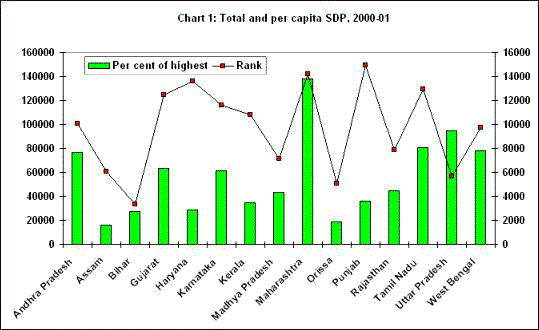
Of course, all
this says nothing about intra-state inequalities, which also cannot be
assumed to be similar across states. The NSS estimates show that some of
the states with highest per capita income have also the highest internal
inequalities in terms of per capita consumption expenditure. Thus, the two
states with the highest Gini coefficients for per capita consumption
(indicating the greatest inequality) are Tamil Nadu (with a Gini ratio of
0.398 in 1999–2000) and Maharashtra (with a Gini ratio of 0.345). These
two states are among the highest in per capita SDP.
However, other states with high per capita SDP show relatively less
inequality in consumption expenditure. Thus Punjab showed a Gini
coefficient of 0.29, while Haryana had a Gini ratio of 0.285 in the same
period, for per capita consumption expenditure. Conversely, some states
with low per capita SDP such as Uttar Pradesh and Bihar had relatively
high inequality with a Gini ratio of 0.327 and 0.318 respectively.
In what follows, we will ignore intra-state income inequalities, and focus
on patterns across states, in terms of per capita income and growth. We
will also ignore rural–urban differentials within states, which are also
estimated to have increased over time and especially in the last decade.
Charts 2 to 5 show the per capita SDP of each state as per cent of the
highest (which in all of the years happens to be Punjab) and the rank of
the various states in the four years 1970–71, 1980–81, 1990–91 and
2000–01. A comparative look at these charts reveals a number of
interesting trends.
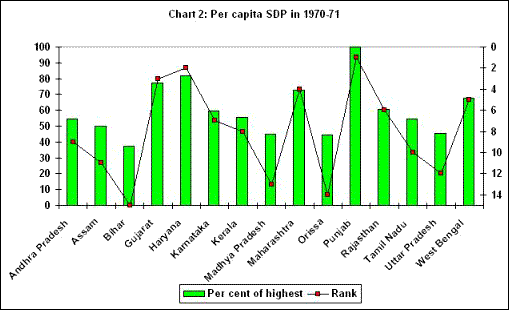
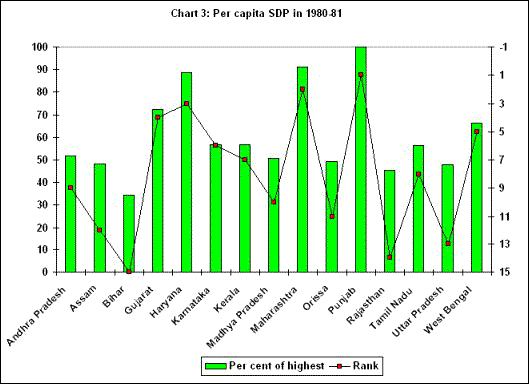

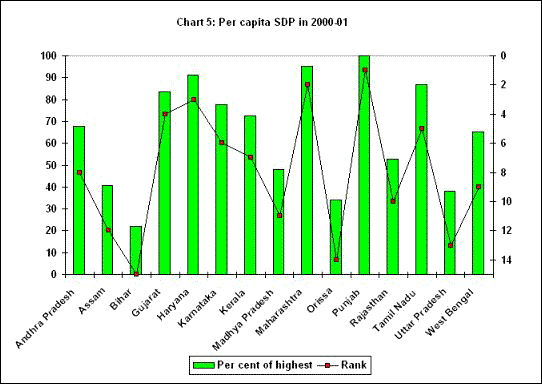
First, it
emerges that over time the basic hierarchy has broadly remained the same,
with Punjab, Haryana and Maharashtra at the top in per capita terms, and
Bihar and Orissa at the bottom. Within this, however, a number of the
states with relatively higher per capita income have been improving their
position vis-ŕ-vis the state with the highest, which is Punjab.
This was especially true for the period 2000–01, when there were four
states (Haryana, Maharashtra, Tamil Nadu and Gujarat) with per capita
incomes of more than 80 per cent of that of Punjab, compared to 1970–71,
when only the state of Haryana could cross that mark. In other words, as
compared to the earlier years, at present there is less difference among
states at the top in terms of per capita incomes.
Another feature that emerges is the variation in the relative position of
the ‘middle income’ states vis-ŕ-vis the highest, not only in terms
of ranking, but as proportions of the highest per capita SDP. States such
as Tamil Nadu, Karnataka and Kerala show significant increases over the
longer period, with some fluctuations in 1990–91. Andhra Pradesh shows
wide fluctuations with an increase in 2000–01, while West Bengal shows no
clear trend, despite a dip in 1990–91 and a recovery thereafter.
Finally, the deterioration of the relative position of the lowest per
capita income states, is worth noting. In the 1970s and 1980s, Orissa and
Bihar (the two states with the lowest per capita SDP) had per capita
incomes between 40 to 50 per cent of that of Punjab; by 2000–01, the
figures had fallen to 34 per cent for Orissa and only 22 per cent for
Bihar. In other words, in some of the more backward states, the
disadvantages of the low base combined with other factors create relative
stagnation in per capita incomes, thus increasing gaps with the richer
states.
This phenomenon of increasing gaps between richest and poorest states is
shown very clearly in Chart 6 that describes the per capita SDP of the
richest state (Punjab) as a multiple of the poorest (Bihar). It shows that
the divergence increased even in the period 1970–90, but not very
substantially, and in 1990–91, the ratio was just above 3 times. But over
the 1990s there was an explosive increase in such inequality that caused
the gap to increase dramatically to more than 4.5 times by 2000–01.
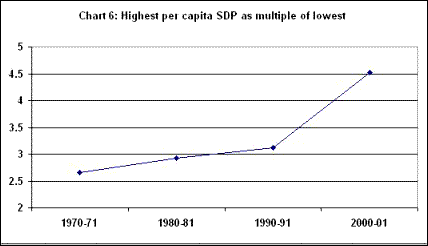
Clearly, the
causes for such increasing divergence over the most recent period require
further investigation. Some possible causes and factors are discussed
below. But before that, it may be worth looking into the patterns of
growth of aggregate SDP, to see if there are any trends that emerge from
such overall performance.
Chart 7 indicates that there has been no such thing as a common pattern
across states in terms of SDP growth rates, and also that the trends have
varied widely across decades. While it is true that some of the more
‘backward’ states exhibit lower rates of growth, this has not been
consistently true over all three decades. Thus, in the 1980s, several of
the supposedly ‘BIMARU’ states (Bihar, Madhya Pradesh, Rajasthan and Uttar
Pradesh) grew faster than the national average in terms of aggregate SDP,
thereby providing challenges to the more common perception. By the 1990s,
however, growth had decelerated in these states (except Rajasthan), but so
also did it slow down in a number of the higher income states such as
Maharashtra, Punjab and Haryana.
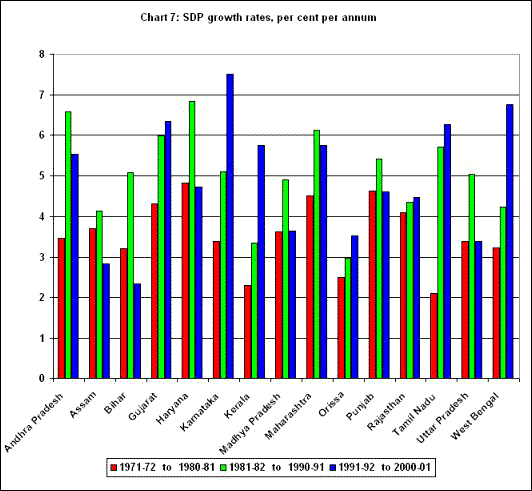
Interestingly, in the 1990s, West Bengal showed the highest rate of
aggregate SDP growth after Karnataka, even though it has not been
generally recognized as a fast growing state. Indeed, its aggregate rate
of growth appears to have been faster than that of Gujarat and Tamil Nadu,
both of which are described as dynamic states. This comes out even more
sharply in terms of per capita incomes. Chart 8 gives some indication of
the aggregate rates of growth and per capita SDP in the second half of the
1990s, for the six largest state economies. Karnataka clearly grew at the
fastest rate, in both aggregate and per capita terms, followed by West
Bengal and Tamil Nadu.
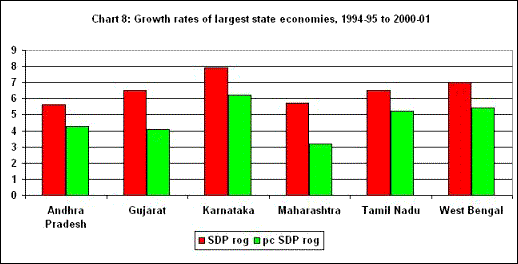
The gap
between West Bengal and Tamil Nadu, on the one hand, and Gujarat and
Andhra Pradesh on the other hand, was significantly greater in terms of
per capita growth, than in aggregate SDP growth. This is possibly
reflective of the greater success of West Bengal and Tamil Nadu in
controlling fertility and therefore also population growth. But once
again, these patterns are not generally recognized.
What is well
known, of course, is that economic growth and per capita income may not be
directly correlated with human development indicators. Table 1 presents
the human development rankings of the major states as calculated by the
Planning Commission, from 1981 to 2001. It is evident that Kerala, which
consistently holds the top position in terms of human development
indicators, is among the middle-income states. Some of the higher income
states are only in the middle ranks of human development.

Further,
growth trends also do not seem to be necessarily correlated with human
development improvement. It is true that Tamil Nadu, which experienced a
relatively higher rate of growth, has also shown a substantial improvement
in human development ranking. However, other fast growing states such as
Karnataka, Gujarat and Andhra Pradesh actually slipped in terms of human
development ranking. Meanwhile, Rajasthan, a state with low income and low
growth rate, showed continuous improvement in its human development rank.
The question, of course, is what explains such regional (or rather,
state-wise) disparities in income and human development, and in
particular, what explains the increase in disparity between richer and
poorer states in the most recent decade. What was it about the overall
growth pattern of the 1990s which, relatively speaking, caused the poorer
states to stagnate, while some states, especially in the southern and
western regions, seem to have accelerated their growth even in per capita
terms? What explains the performance of states like West Bengal and Kerala,
which are not generally accepted to be fast growing states? And why do
income and human development indicators diverge so much?
Parts of the last question can be answered in terms of the difference
between income and consumption, which is indicated in Table 2. This table
suggests several features of interest.

First, there
is a wide divergence between the per capita consumption estimates of the
NSS and the per capita SDP data, even at the top of the hierarchy. Thus,
Kerala, which is only seventh in ranking in per capita SDP, tops the list
in per capita consumption. Maharashtra, which is second in per capita SDP
ranking, is fifth in per capita consumption.
Second, the inter-state disparities are less in terms of per capita
consumption that emerges in terms of per capita SDP. Thus, the gap between
the highest per capita consumption figure (in Kerala) and the lowest (in
Orissa) was 1.98 times in 1999–2000, which is lower than the gap of 4.5
times which we observed for per capita SDP in 2000–01.
Clearly, human development indicators (which capture longevity and
educational attainment along with income) are more likely to be affected
by per capita consumption in a state than by per capita income. Therefore,
it is not surprising that we find greater correlation between the
consumption and human development rankings, than we do between SDP and
human development rankings.
The question remains why some of the high income states exhibit relatively
less per capita consumption. This anomaly points to higher savings and
investment ratios in such states, but it should be noted that some of
these states, such as Maharashtra, have not necessarily been high growth
states, especially in the recent times.
Until the 1970s, there was actually a convergence of per capita incomes
across states, or at least a decline in the extent of inter-state
disparities in this regard. This reflected deliberate government
intervention, expressed in various ways. The successive Finance
Commissions showed positive discrimination in favour of poorer states in
the transfer of tax revenues of the government, and funds also were partly
directed with this in mind. Incentives for industrial investment and
activity in poorer states and more backward regions were also provided. As
these became less significant, the forces making for convergence got
weakened, and the greater play allowed to market forces began to
strengthen the process of divergence of per capita incomes across states.
In general, the 1990s are likely to have been associated with greater
inequality of per capita SDP across states, also because of fiscal
patterns across India and within particular states. This was a period of
greater centralization of tax revenues, and reduced fiscal transfers from
the Central to the State governments. It is important to remember that,
unlike the Central government, State governments do face budget
constraint, and this affects their ability to spend in important ways.
This meant that state governments found they had less resource to
undertake important infrastructure and other investment, which in turn had
adverse effects on growth and on subsequent economic activity.
While all state governments were adversely affected, and indeed there is
now a fiscal crisis in practically every state, some states were worse off
than others. These were the states where previous growth and per capita
incomes were low as they were unable to generate more sales tax and other
such revenues from economic activity. On the other hand, states where
economic activity grew at a faster rate were able to generate more tax
revenues and were therefore able to invest in infrastructure, transport,
power and so on. This was certainly true in the southern states of
Karnataka and Tamil Nadu, where, in the recent decade, there has been
substantial expansion of transport infrastructure in particular. By
contrast, states such as Bihar, Orissa and Uttar Pradesh found themselves
to be so cash-strapped that they could not maintain the existing
infrastructure projects, and the providing of basic facilities in per
capita terms too showed a further decline. So the fiscal constraint
operated to add to the stagnationary tendencies already present in certain
states, which meant the widening of the gap between the richer and poorer
states over the 1990s.
In this context, the relatively better growth performance of states like
West Bengal and Kerala in the 1990s deserves further investigation.
Different forces may have been operating in the two states. In West
Bengal, while agriculture led the growth of the 1980s, in the 1990s the
impulse seems to have come more from the expansion of services and rural
industrialization. In Kerala on the other hand, services growth played a
significant role, especially driven by the effect of the inflow of
remittances from migrant workers from Kerala in the Gulf region.
What all this discussion indicates is that the actual behaviour over time
of per capita SDP in the various states, and of per capita consumption, is
rather different from that projected by the more stereotypical notions
regarding economic differences in different parts of India.
© MACROSCAN
2003